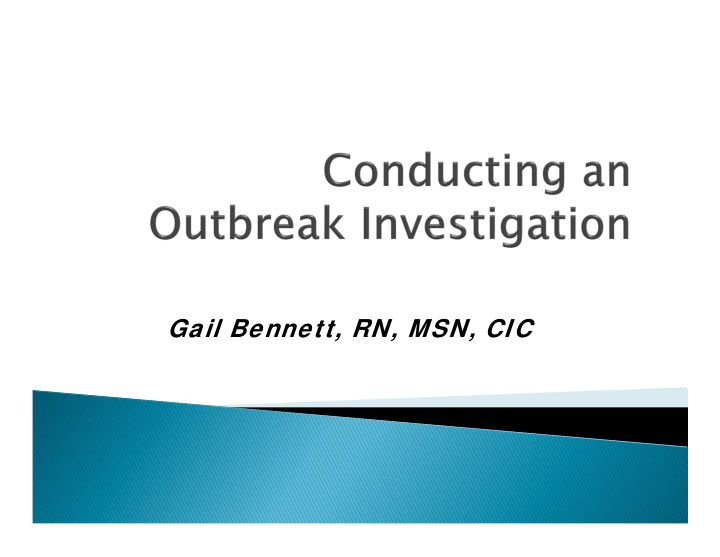



Gail Bennett, RN, MSN, CIC
The occurrence of more cases of disease than expected in a given area or among a specific group of people over a particular period of time Cases above your usual endemic rate
What got your attention? Is there a specific diagnosis? What agent has been identified? ◦ Bacterial ◦ Viral ◦ Fungal ◦ Other
Define the case—Establish or verify the diagnosis of reported cases, including… ◦ WHAT: The pathogen, site, and clinical signs and symptoms ◦ WHO: Characteristics of the population in which the problem is occurring ◦ WHERE: Geographic location of the problem ◦ WHEN: How long the problem has been occurring Keep case definition simple, objective and measurable Definition may need redefining after further data collection
◦ Case-finding – use your case definition ◦ Total number of cases so far ◦ Compare the current incidence with the usual or baseline incidence ◦ Institute early control measures ◦ Open lines of communication ◦ If an outbreak exists, PROCEED.
A 2 to 2.5 fold increase in the infection rate of any site, pathogen or site and pathogen combination almost always justifies an evaluation
Use the case definition Alert others to report cases ◦ Lab ◦ MDs ◦ Staff ◦ Outpatient clinics
Person: characteristics ◦ Age ◦ Sex ◦ Disease ◦ Exposures ◦ Treatments Place ◦ Hall ◦ Room ◦ Unit ◦ Outside exposures Time ◦ Period of the outbreak ◦ Probable source
An epidemic curve (epi curve) is a graphical depiction of the number of cases of illness by the date of illness onset Epi Curve slides from UNC School of Public Health
An epi curve can provide information on the following characteristics of an outbreak: ◦ Pattern of spread ◦ Magnitude ◦ Outliers ◦ Time trend ◦ Exposure and/or disease incubation period
The overall shape of the epi curve can reveal the type of outbreak ◦ Common source ◦ Point source ◦ Propagated
People are exposed continuously or intermittently to a harmful source Period of exposure may be brief or long Intermittent exposure often results in an epi curve with irregular peaks that reflect the timing and the extent of exposure
Continuous exposure will often cause cases to rise gradually (and possibly to plateau, rather than to peak)
Typically shows a sharp upward slope and a gradual downward slope Is a common source outbreak in which the period of exposure is brief, and all cases occur within one incubation period
Is spread from person to person Can last longer than common source outbreaks May have multiple waves The classic epi curve for a propagated outbreak has progressively taller peaks, an incubation period apart
Review the literature Best guess re: ◦ Reservoir ◦ Source ◦ Mode of Transmission
Don’t forget: Commercially supplied medications and devices suspected as causes of an outbreak should be reported to the CDC and FDA immediately Slide courtesy of Connie Steed
Save everything! Cohort supplies which might be suspect in the outbreak Contact microbiology lab to save all patient isolates Slide courtesy of Connie Steed
Use a notebook to keep accurate documentation of activities Collect information on all cases: Decide ahead of time what you will need to look at ◦ Demographic data-name, age, sex, date of admission, infection onset ◦ Risk factors-procedures, medical devices, medication ◦ Host factors-diabetes malignancy, immunodeficiency Slide courtesy of Connie Steed ◦
Control Date added Document measures control measures and when implemented Is assistance needed??
Outbreak may end before you get to this point Epidemiologic studies may be necessary Get help if needed
Add additional measures if needed Delete any not determined to be helpful
Insure compliance! If you don’t look, you don’t know! Have cases stopped? ◦ If not, consider additional measures
Your outbreak investigation paperwork – forms, line listings, etc may become part of your report
Recommend
More recommend